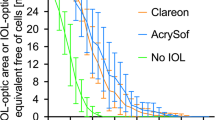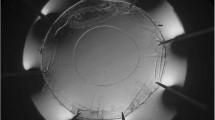Abstract
Purpose
To investigate the effect of different intraocular lenses (IOLs) on lens epithelial cells (LECs) and on human capsular bags in vitro and to evaluate the transferability of this model to clinical situations.
Methods
Sham cataract surgery, including IOL-into-the-bag implantation, was performed on 38 donor eyes after removal of the cornea. The capsular bag including the IOL was removed, pinned on a culture dish, covered with medium, and incubated. Two different IOLs were compared per pair of donor eyes. In each pair of donor eyes, the two different IOLs to be compared were implanted individually into capsular bags. The time required for complete coverage of the posterior capsule by a confluent monolayer of LECs was documented. The following IOLs were compared: three-piece acrylic IOLs of different sizes and single-piece polymethylmethacrylate (PMMA) versus acrylic IOLs.
Results
A complete monolayer of LECs on the posterior capsule was observed to form at times varying from 8 days (PMMA IOLs) to more than 60 days (three-piece hydrophobic acrylic IOLs). A significant difference between PMMA IOLs and hydrophobic acrylic IOLs was found.
Conclusions
The human capsular bag model employed allows short-term evaluation of secondary cataract formation for different IOLs. This model’s correlation with clinical results is good.





Similar content being viewed by others
References
Apple DJ, Solomon KD, Tetz MR, Assia EI, Holland EY, Legler UF, Tsai JC, Castaneda VE, Hoggatt JP, Kostick AM (1992) Posterior capsule opacification. Surv Ophthalmol 37:73–116
Apple DJ, Peng Q, Visessook N, Werner L, Pandey SK, Escobar-Gomez M, Ram J, Auffarth GU (2001) Eradication of posterior capsule opacification. Documentation of a marked decrease in Nd:YAG laser posterior capsulotomy rates noted in an analysis of 5416 pseudophakic human eyes obtained postmortem. Ophthalmology 108:505–518
Buehl W, Findl O, Menapace R, Rainer G, Sacu S, Kiss B, Petternel V, Georgopoulos M (2002) Effect of an acrylic intraocular lens with a sharp posterior optic edge on posterior capsule opacification. J Cataract Refract Surg 28:1105–1111
Cobo LM, Ohsawa E, Chandler D, Arguello R, George G (1984) Pathogenesis of capsular opacification after extracapsular cataract extraction: an animal model. Ophthalmology 91:857–863
Hayashi H, Hayashi K, Nakao F, Hayashi F (1998) Quantitative comparison of posterior capsule opacification after polymethylmethacrylate, silicone, and soft acrylic intraocular lens implantation. Arch Ophthalmol 116:1579–1582
Hollick EJ, Spalton DJ, Ursell PG, Pande MV, Barman SA, Boyce JF, Tilling K (1999) The effect of polymethylmethacrylate, silicone, and polyacrylic intraocular lenses on posterior capsular opacification 3 years after cataract surgery. Ophthalmology 106:49–55
Kojetinsky C, Baatz H, Pleyer U, Hartmann C, Rieck P (2001) In-vitro-Untersuchungen an bovinen und humanen Linsenepithelzellkulturen zur Nachstarhemmung mittels eines zyklischen RGD-peptids. Ophthalmologe 98:731–735
Kurosaka D, Nagamoto T (1994) Inhibitory effect of TGF-beta 2 in human aqueous humor on bovine lens epithelial cell proliferation. Invest Ophthalmol Vis Sci 35:3408–3412
Liu CSC, Wormstone IM, Duncan G, Marcantonio JM, Webb SF, Davies PD (1996) A study of human lens cell growth in vitro. A model for posterior capsule opacification. Invest Ophthalmol Vis Sci 37:906–914
McDonnell PJ, Kranse W, Glaser BM (1988) In vitro inhibition of lens epithelial cell proliferation and migration. Ophthalmic Surg 19:25–30
Meacock WR, Spalton DJ, Boyce JF, Jose RM (2001) Effect of optic size on posterior capsule opacification: 5.5mm versus 6.0mm AcrySof intraocular lenses. J Cataract Refract Surg 27:1194–1198
Nishi O, Nishi K, Sakanishi K (1998) Inhibition of migrating lens epithelial cells at the capsular bend created by the rectangular optic edge of posterior chamber intraocular lens. Ophthalmic Surg Lasers 29:587–594
Odrich MG, Hall SJ, Worgul BV, Trokel SL, Rini FJ (1985) Posterior capsule opacification: experimental analyses. Ophthalmic Res 17:75–84
Ohadi C, Moreira H, McDonnell PJ (1991) Posterior capsule opacification. Curr Opin Ophthalmol 2:46–52
Oshika T, Suzuki Y, Kizaki H, Yaguchi S (1996) Two year study of a soft acrylic intraocular lens. J Cataract Refract Surg 22:104–109
Power WJ, Neylan D, Collum LM (1994) Daunomycin as an inhibitor of human lens epithelial cell proliferation in culture. J Cataract Refract Surg 20:287–290
Sundelin K, Fridberg-Riad Y, Ostberg A, Sjöstrand J (2001) Posterior capsule opacification with AcrySof and poly(methylmethacrylate) intraocular lenses: comparative study with a 3-year follow-up. J Cataract Refract Surg 27:1586–1590
Tarsio JF, Kelleher PJ, Tarsio M, Emery JM, Lam DM-K (1997) Inhibition of cell proliferation on lens capsules by 4197X-ricin A immunoconjugate. J Cataract Refract Surg 23:260–266
Ursell PG, Spalton DJ, Pande MV, Hollick EJ, Barman S, Boyce J, Tilling K (1998) Relationship between intraocular lens biomaterials and posterior capsule opacification. J Cataract Refract Surg 24:352–360
Vargas LG, Peng Q, Apple DJ, Escobar-Gomez M, Pandey SK, Arthur SN, Hoddinott DSM, Schmidbauer JM (2002) Evaluation of 3 modern single-piece foldable intraocular lenses. Clinicopathological study of posterior capsule opacification in a rabbit model. Cataract Refract Surg 28:1241–1250
Acknowledgements
We would like to express our gratitude to J. Marcantonio, G. Duncan and M. Wormstone for allowing us to benefit from their great experience. We also thank Pharmacia and Alcon for providing the IOL samples.
Author information
Authors and Affiliations
Corresponding author
Rights and permissions
About this article
Cite this article
Liekfeld, A., Pahms, N., Torun, N. et al. Evaluation of a human capsular bag model for secondary cataract determination after intraocular lens implantation. Graefe's Arch Clin Exp Ophthalmol 243, 43–48 (2005). https://doi.org/10.1007/s00417-004-0972-1
Received:
Revised:
Accepted:
Published:
Issue Date:
DOI: https://doi.org/10.1007/s00417-004-0972-1




